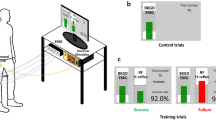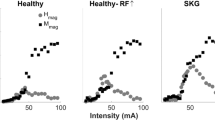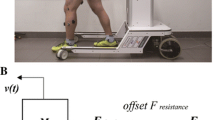Abstract
The application of resistance during the swing phase of locomotion is a viable approach to enhance activity in the rectus femoris (RF) in patients with neurological damage. Increased muscle activity is also accompanied by changes in joint angle and stride frequency, consequently influencing joint angular velocity, making it difficult to attribute neuromuscular changes in RF to resistance. Thus, the purpose of this study was to evaluate the effects of resistance on RF activity while constraining joint trajectories. Participants walked in three resistance conditions; 0 % (no resistance), 5 and 10 % of their maximum voluntary contraction (MVC). Visual and auditory biofeedback was provided to help participants maintain the same knee joint angle and stride frequency as during baseline walking. Lower limb joint trajectories and RF activity were recorded. Increasing the resistance, while keeping joint trajectories constant with biofeedback, independently enhanced swing phase RF activity. Therefore, the observed effects in RF are related to resistance, independent of any changes in joint angle. Considering resistance also affects stride frequency, a second experiment was conducted to evaluate the independent effects of resistance and stride frequency on RF activity. Participants walked in four combinations of resistance at 0 and 10 %MVC and natural and slow stride frequency conditions. We observed significant increases in RF activity with increased resistance and decreased stride frequency, confirming the independent contribution of resistance on RF activity as well as the independent effect of stride frequency. Resistance and stride frequency may be key parameters in gait rehabilitation strategies where either of these may be manipulated to enhance swing phase flexor muscle activity in order to maximize rehabilitation outcomes.





Similar content being viewed by others
References
af Klint R, Nielsen JB, Cole J, Sinkjaer T, Grey MJ (2008) Within-step modulation of leg muscle activity by afferent feedback in human walking. J Physiol 586:4643–4648
Barbeau H, Fung J (2001) The role of rehabilitation in the recovery of walking in the neurological population. Curr Opin Neurol 14:735–740
Bolliger M, Banz R, Dietz V, Lunenburger L (2008) Standardized voluntary force measurement in a lower extremity rehabilitation robot. J Neuroeng Rehabil 5:23
Bonnard M, Camus M, Coyle T, Pailhous J (2002) Task-induced modulation of motor evoked potentials in upper-leg muscles during human gait: a TMS study. Eur J Neurosci 16:2225–2230
Capaday C, Lavoie BA, Barbeau H, Schneider C, Bonnard M (1999) Studies on the corticospinal control of human walking. I. Responses to focal transcranial magnetic stimulation of the motor cortex. J Neurophysiol 81:129–139
Danion F, Varraine E, Bonnard M, Pailhous J (2003) Stride variability in human gait: the effect of stride frequency and stride length. Gait Posture 18:69–77
Degtyarenko AM, Simon ES, Norden-Krichmar T, Burke RE (1998) Modulation of oligosynaptic cutaneous and muscle afferent reflex pathways during fictive locomotion and scratching in the cat. J Neurophysiol 79:447–463
Dietz V, Duysens J (2000) Significance of load receptor input during locomotion: a review. Gait Posture 11:102–110
Dietz V, Quintern J, Boos G, Berger W (1986) Obsturction of the swing phase during gait: phase-dependent bilateral leg muscle coordination. Brain Res 384:166–169
Dietz V, Colombo G, Muller R (2004) Single joint perturbation during gait: neuronal control of movement trajectory. Exp Brain Res 158:308–316
Donelan JM, Pearson KG (2004) Contribution of force feedback to ankle extensor activity in decerebrate walking cats. J Neurophysiol 92:2093–2104
Eng JJ, Winter DA, Patla AE (1994) Strategies for recovery from a trip in early and late swing during human walking. Exp Brain Res 102:339–349
Field-Fote EC, Dietz V (2007) Single joint perturbation during gait: preserved compensatory response pattern in spinal cord injured subjects. Clin Neurophysiol 118:1607–1616
Garrett M, Luckwill RG (1983) Role of reflex responses of knee musculature during the swing phase of walking in man. Eur J Appl Physiol Occup Physiol 52:36–41
Ghori GMU, Luckwill RG (1989) Pattern of reflex responses in lower-limb muscles to a resistance in walking man. Eur J Appl Physiol Occup Physiol 58:852–857
Grieve DW, Gear RJ (1966) The relationships between length of stride, step frequency, time of swing and speed of walking for children and adults. Ergonomics 9:379–399
Hagbarth KE, Vallbo AB (1968) Discharge Characteristics of Human Muscle Afferents during Muscle Stretch and Contraction. Exp Neurol 22:674
Hawkins D, Hull ML (1990) A method for determining lower extremity muscle-tendon lengths during flexion/extension movements. J Biomech 23:487–494
Hiebert GW, Whelan PJ, Prochazka A, Pearson KG (1996) Contribution of hind limb flexor muscle afferents to the timing of phase transitions in the cat step cycle. J Neurophysiol 75:1126–1137
Houldin A, Luttin K, Lam T (2011) Locomotor adaptations and aftereffects to resistance during walking in individuals with spinal cord injury. J Neurophysiol 106:247–258
Klarner T, Chan HK, Wakeling JM, Lam T (2010) Patterns of muscle coordination vary with stride frequency during weight assisted treadmill walking. Gait & Posture 31:360–365
Lam T, Pearson KG (2001) Proprioceptive modulation of hip flexor activity during the swing phase of locomotion in decerebrate cats. J Neurophysiol 86:1321–1332
Lam T, Pearson KG (2002) Sartorius muscle afferents influence the amplitude and timing of flexor activity in walking decerebrate cats. Exp Brain Res 147:175–185
Lam T, Anderschitz M, Dietz V (2006) Contribution of feedback and feedforward strategies to locomotor adaptations. J Neurophysiol 95:766–773
Lam T, Wirz M, Lunenburger L, Dietz V (2008) Swing phase resistance enhances flexor muscle activity during treadmill locomotion in incomplete spinal cord injury. Neurorehabil Neural Repair 22:438–446
Lam T, Luttmann K, Houldin A, Chan C (2009) Treadmill-based locomotor training with leg weights to enhance functional ambulation in people with chronic stroke: a pilot study. J Neurol Phys Ther 33:129–135
Lam T, Pauhl K, Krassioukov A, Eng JJ (2011) Using robot-applied resistance to augment body-weight-supported treadmill training in an individual with incomplete spinal cord injury. Phys Ther 91:143–151
Lam T, Pauhl K, Bigelow A, Krassioukov A, Eng JJ (2012) Treadmill training with Lokomat-applied resistance to enhance ambulation in people with incomplete spinal cord injury. In: American Physical Therapy Association Combined Sections Meeting, Chicago, USA, pp 8–12
Masumoto K, Takasugi S, Hotta N, Fujishima K, Iwamoto Y (2004) Electromyographic analysis of walking in water in healthy humans. J Physiol Anthropol Appl Human Sci 23:119–127
McCrea D, Stecina K, Quevedo J, Gosgnach S (2000) Flexor group II muscle afferents can enhance flexor activity during fictive locomotion. Abstr Soc Neurosci 26:1233
Mena D, Mansour JM, Simon SR (1981) Analysis and synthesis of human swing leg motion during gait and its clinical applications. J Biomech 14:823–832
Nielsen JB, Sinkjaer T (2002) Afferent feedback in the control of human gait. J Electromyogr Kinesiol 12:213–217
Noble JW, Prentice SD (2006) Adaptation to unilateral change in lower limb mechanical properties during human walking. Exp Brain Res 169:482–495
Pearson KG, Collins DF (1993) Reversal of the influence of group Ib afferents from plantaris on activity in medial gastrocnemius muscle during locomotor activity. J Neurophysiol 70:1009–1017
Perreault MC, Angel MJ, Guertin P, McCrea DA (1995) Effects of stimulation of hindlimb flexor group II afferents during fictive locomotion in the cat. J Physiol 487(Pt 1):211–220
Prochazka A, Gillard D, Bennett DJ (1997) Implications of positive feedback in the control of movement. J Neurophysiol 77:3237–3251
Quevedo J, Fedirchuk B, Gosgnach S, McCrea DA (2000) Group I disynaptic excitation of cat hindlimb flexor and bifunctional motoneurons during fictive locomotion. J Physiol 525(Pt 2):549–564
Schwameder H, Lindenhofer E, Muller E (2005) Effect of walking speed on lower extremity joint loading in graded ramp walking. Sports Biomech 4:227–243
Winter DA (1991) The Biomechanics and Motor Control of Human Gait: Normal, Elderly and Pathological. University of Waterloo Press, Waterloo
Zehr EP, Stein RB (1999) What functions do reflexes serve during human locomotion? Prog Neurobiol 58:185–205
Acknowledgments
We thank Laurent Mingo for valuable assistance in programming. This study was supported by the Natural Sciences and Engineering Research Council of Canada (NSERC). TL is supported by a Canadian Institutes for Health Research New Investigator Award.
Author information
Authors and Affiliations
Corresponding author
Rights and permissions
About this article
Cite this article
Klarner, T., Blouin, JS., Carpenter, M.G. et al. Contributions to enhanced activity in rectus femoris in response to Lokomat-applied resistance. Exp Brain Res 225, 1–10 (2013). https://doi.org/10.1007/s00221-012-3345-8
Received:
Accepted:
Published:
Issue Date:
DOI: https://doi.org/10.1007/s00221-012-3345-8




